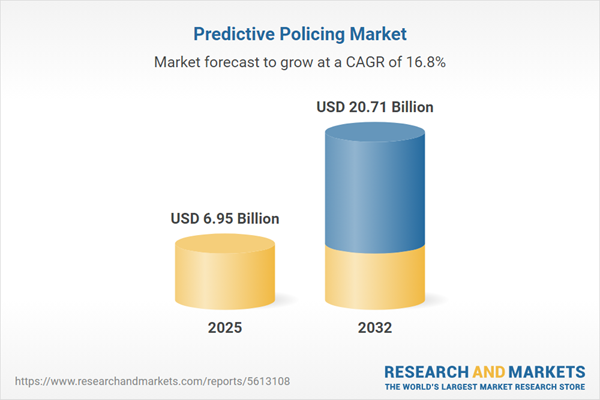Speak directly to the analyst to clarify any post sales queries you may have.
Predictive policing is redefining public safety operations by providing senior decision-makers with advanced analytical tools that improve strategic planning, enable real-time threat response, and support refined resource management across diverse security environments.
Market Snapshot: Predictive Policing Market Growth and Outlook
The predictive policing market is exhibiting substantial momentum, valued at USD 5.96 billion in 2024 and expected to reach USD 6.95 billion by 2025. Reflecting a CAGR of 16.84%, this growth demonstrates sector-wide enthusiasm for digital transformation. Public safety agencies are increasingly prioritizing intelligence-led approaches, allowing them to strengthen responsiveness and adapt rapidly to evolving security risks. Strong partnerships between public sector organizations and private technology companies continue to inspire the development of innovative risk management technologies and analytics-driven solutions, ensuring that the predictive policing market remains a core component of modern security infrastructure. These collaborative advancements address both operational sustainability and stakeholder requirements for compliance, efficiency, and adaptability.
Scope & Segmentation
- End Users: Federal, state, and local police departments, private security providers, and community safety organizations each leverage predictive policing platforms to suit specific operational mandates and local risk factors.
- Applications: Solutions span crime forecasting, resource allocation, event risk assessment, suspect identification, and integration with behavioral analytics, offering actionable intelligence for proactivity in threat management.
- Offerings: Advisory services, end-to-end platform integration, deployment support, analytics software, and data visualization applications comprise the suite of capabilities available to public safety stakeholders.
- Technologies: Key technical enablers include data mining, classification, clustering, regression, geospatial mapping, and machine learning, all of which contribute to deep, actionable risk analysis for informed decision-making.
- Regions: Adoption trends differ across key markets such as the Americas (including the United States, Canada, Brazil, Mexico), EMEA (United Kingdom, Germany, France, Middle East, Africa), and Asia-Pacific (China, India, Japan, Australia and adjacent markets), with each region’s regulatory climate and digital infrastructure influencing readiness and solution uptake.
- Leading Companies: Technology providers driving industry standards include Palantir Technologies Inc., IBM, SAS Institute Inc., Motorola Solutions Inc., NICE Ltd., NEC Corporation, Verint Systems Inc., Microsoft Corporation, Cisco Systems Inc., and SAP SE.
Predictive Policing: Key Takeaways for Senior Leaders
- Advanced analytics and artificial intelligence equip public safety agencies with tools to anticipate and mitigate emerging threats before escalation.
- Geospatial analysis and machine learning facilitate efficient resource allocation, optimizing the response to complex security challenges at both local and regional levels.
- Adopting interoperable technology platforms streamlines integration with existing systems and regulatory frameworks, enabling agencies to maintain consistency through organizational transitions.
- Emphasis on ethical practices and data protection not only strengthens transparency but also underpins stakeholder trust and accountability throughout the security ecosystem.
- Collaboration between public institutions and the private sector accelerates technology adoption, enhancing agility while maintaining alignment with established compliance requirements.
- Continuous advancements in analytics and interactive visualization are empowering leaders to make investment decisions aligned with strategic security objectives and cross-departmental goals.
Tariff Impact on Predictive Policing Technologies
Evolving tariff policies in the United States have driven public safety agencies to prefer domestic vendors and deploy hybrid infrastructure that leverages both cloud and on-premises solutions. This strategic shift safeguards continuity of operations, boosts analytic performance, and offers controllable cost structures. It also underscores the importance of sustained partnerships between solution providers and agency leaders for regulatory compliance and dependable system performance.
Methodology & Data Sources
This report integrates insights collected directly from public safety leaders and technology executives, supported by academic research, regulatory documents, and select industry datasets. These diverse data sources ensure a high degree of reliability and sector standard alignment.
Why This Predictive Policing Report Matters
- Empowers senior leaders to structure predictive policing strategies that align with compliance imperatives and organizational objectives.
- Identifies emerging partnership models and operational trends that contribute to adaptive, evidence-based safety initiatives in both public and private sectors.
- Clarifies the evolving regulatory landscape, delivering actionable guidance and transparent processes for ongoing operational resilience.
Conclusion
Applying the findings from this report enables decision-makers to strengthen oversight, accelerate modernization efforts, and boost preparedness within the dynamic landscape of public safety management.
Additional Product Information:
- Purchase of this report includes 1 year online access with quarterly updates.
- This report can be updated on request. Please contact our Customer Experience team using the Ask a Question widget on our website.
Table of Contents
3. Executive Summary
4. Market Overview
7. Cumulative Impact of Artificial Intelligence 2025
Companies Mentioned
The companies profiled in this Predictive Policing market report include:- Palantir Technologies Inc.
- International Business Machines Corporation
- SAS Institute Inc.
- Motorola Solutions, Inc.
- NICE Ltd.
- NEC Corporation
- Verint Systems Inc.
- Microsoft Corporation
- Cisco Systems, Inc.
- SAP SE
Table Information
| Report Attribute | Details |
|---|---|
| No. of Pages | 198 |
| Published | October 2025 |
| Forecast Period | 2025 - 2032 |
| Estimated Market Value ( USD | $ 6.95 Billion |
| Forecasted Market Value ( USD | $ 20.71 Billion |
| Compound Annual Growth Rate | 16.8% |
| Regions Covered | Global |
| No. of Companies Mentioned | 11 |









